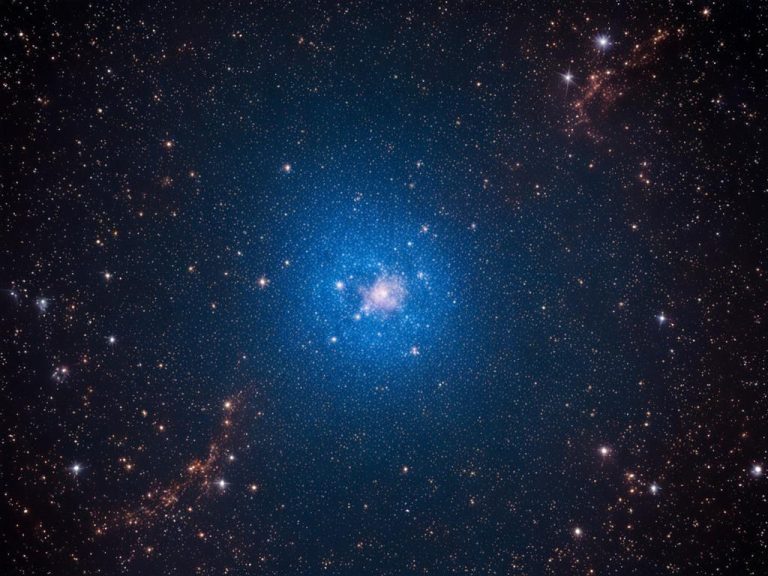Explore the Wonders of the Pegasus Constellation
The Pegasus Constellation is known for its fascinating myths and beauty in the sky. Astronomers and stargazers have been intrigued for ages. This special constellation is named after the pegasus mythological creature.
It covers a big part of the northern sky. Because of this, it’s easy to spot and is a main part of our night views.
The Pegasus constellation is a huge part of the sky, spanning 1121 square degrees in the Northern Hemisphere’s fourth quadrant.
Autumn evenings in the northern hemisphere are the best times to see Pegasus. It holds an asterism called The Great Square. This guide composed of stars has been helping travelers for a long time.
One special star in Pegasus is the Pegasus Star, also called 51 Pegasi. It’s located about 50.9 light-years from us. Scientists find it interesting because of its special traits and the objects around it.
Key Takeaways:
- Pegasus is a huge part of the night sky, covering 1121 square degrees.
- The Great Square of Pegasus has been guiding people for centuries.
- The Pegasus Star is about 50.9 light-years away from Earth.
- It’s best to look at Pegasus in autumn in the northern hemisphere.
- The Pegasus Constellation mixes myth and science in a fascinating way.

Pegasus Mythology Myths: What is a Pegasus?
In Greek mythology, Pegasus is a captivating creature. It is a winged horse that came from Medusa’s neck when killed by Perseus. This amazing mythical creature has amazed people for centuries.
Pegasus inspires poets and artists. It is a symbol of creativity and imagination. Stories tell of Pegasus helping Zeus and Poseidon, the gods, in their deeds.
Pegasus is said to have created a special spring on Mount Helicon by hitting the ground. This spring, named Hippocrene, was a source of inspiration. It was also known for its magical powers. Pegasus was important for carrying Zeus’ thunderbolts.
The story of Pegasus deepens the wonder of the Pegasus constellation. Its link to the mythical creature is clear. This makes the constellation even more fascinating.
- Mythology portrays Pegasus as a winged horse sprung from the neck of Medusa when she was slain by Perseus.
- Pegasus symbolizes poetic inspiration and is associated with the gods Zeus and Poseidon.
- The creature played a role in creating the spring of Hippocrene and carrying Zeus’ thunderbolts.
- The mythological significance of Pegasus adds allure and mystique to the constellation.
The Great Square of the Pegasus Constellation
The Great Square of Pegasus is an amazing part of the Pegasus constellation. It is made up of four stars: Scheat, Alpheratz, Markab, and Algenib. These stars look like a lopsided square and are easy to see in the fall from the Northern Hemisphere.
The Great Square helps stargazers find other cool things in the sky. By learning to hop from star to star, you can find the Andromeda Galaxy. It’s about 15 degrees wide and 20 degrees long diagonally.
To learn more about the Great Square and Pegasus, check out places like EarthSky. They explain why the pattern is special in autumn.
For even more info and tips on finding the Great Square, Sky at Night Magazine is a great resource. They offer articles and advice to help you understand the night sky better.
Also, Astronomy Now talks about the beauty and meaning of the Great Square in autumn. This can make you appreciate the pattern even more.
International Star Registry
Imagine immortalizing a special moment or commemorating a loved one’s memory by naming a star in the celestial realm of Pegasus. With International Star Registry, you have the opportunity to do just that. Whether it’s a birthday, Christmas, or anniversary gift, naming a star is a unique and heartfelt gesture that will be cherished for a lifetime.
By purchasing a star through International Star Registry, you not only acquire the right to name a star but also receive a personalized star certificate and celestial map, detailing the precise location of your named star within the Pegasus constellation. It’s a meaningful way to honor someone special or celebrate a significant milestone.
This constellation is a favorite among celebrities. Some celebrities that have their very own stars named in Pegasus include Drew Barrymore, Kathy Baker, and Sylvia Browne, Diana Princess of Wales, Nancy Juvonen, Teri Hatcher and, Mandy Moore

Dive into the amazing world of the Great Square of Pegasus. When you explore its myths and science, you open a door to the wonders of the sky at night.
Pegasus Star: 51 Pegasi
51 Pegasi, or the Pegasus Star, is in the Pegasus constellation. It has changed the way we see the universe. This star is very important in astronomy because of its big discovery.
In 1995, scientists found something amazing. They found a planet, 51 Pegasi b, going around the Pegasus Star. This was the first time we saw a planet around a star like our Sun. It started a new area of study about planets around other stars.
You can see the Pegasus Star without a telescope. It’s a favorite for both scientists and people who love looking at the stars. It’s about 50.6 light-years from Earth.
This star is really interesting for scientists. Its brightness and other features tell a lot about it. For example, it moves away from us at -33.33 km/s.
The Pegasus Star weighs about 1.12 times more than our Sun. It’s about 1.237 times bigger than our Sun too. With a temperature of 5,768 ± 8 K, it shines brightly in the sky. Its metallicity [Fe/H] at +0.20 dex gives us clues about what’s in its air.
51 Pegasi isn’t just an important star for science. It’s part of the big Pegasus constellation. Pegasus is really big too. It’s the seventh-largest out of 88 constellations. And, it’s home to 12 stars that have planets.
To learn more about Pegasus and 51 Pegasi, check these out:
- 51 Pegasi: Find out more on Wikipedia.
- Pegasus (Constellation): Explore its stories and history.
- Pegasus Constellation Facts: Learn interesting facts about Pegasus.
Studying stars like 51 Pegasi shows us the universe’s amazing secrets. It makes us wonder about what else is out there. And it encourages us to keep learning about space.
References
- 51 Pegasi on Wikipedia: https://en.wikipedia.org/wiki/51_Pegasi
- Pegasus (Constellation) on Wikipedia: https://en.wikipedia.org/wiki/Pegasus_(constellation)
- Pegasus Constellation Facts: https://www.constellation-guide.com/constellation-list/pegasus-constellation/
Characteristics of the Pegasus Star
The Pegasus Constellation wows both astronomers and star lovers. It’s full of cosmic beauty, with the Pegasus Star, 51 Pegasi, shining bright.
Similar to our Sun, it’s a yellow dwarf star. But, it’s a bit bigger and brighter. Its golden light fills the night, being larger and warmer than the Sun. With a hot surface of around 5,600 Kelvin, its beauty is clear to see.
The Pegasus Star is different from our Sun in one way. It has more heavy elements, a fact we call metallicity. This difference helps us learn more about how stars form and change over time.
This star takes about 37 days to complete one slow, elegant spin. It’s between 6.1 to 8.1 billion years old, a true timekeeper in the vast universe.
Understanding the Pegasus Star is key for astronomers. It teaches us about the life story of stars. In turn, this knowledge helps us uncover the universe’s secrets.

For those who want to learn more about Pegasus and its stars, visit sites like The Planets and Astronomy Trek. These places offer lots of info, star maps, and interesting looks at the Pegasus constellation.
Exoplanet Orbiting the Pegasus Star
The Pegasus constellation is famous for its bright star designs and amazing exoplanets. One exoplanet, 51 Pegasi b, has amazed scientists and fans of space. Its discovery changed how we see planetary systems and led to more space exploration.
51 Pegasi b, also called “Bellerophon,” is a gas giant like Jupiter but with a twist. Jupiter is far from the Sun, but 51 Pegasi b is so close to its star that it orbits every 4.2 days. This makes it a “hot Jupiter.”
Michel Mayor and Didier Queloz found 51 Pegasi b in 1995. Its discovery showed that gas giants could also be very close to their stars. This broke old ideas and sparked new ways of finding exoplanets.
51 Pegasi b weighs about half of Jupiter, making it important in the Pegasus constellation. learning about its makeup and air tells us about the variety of planets in space.
Significance of 51 Pegasi b’s Discovery
The discovery of 51 Pegasi b changed how we see space forever. It’s in the Pegasus constellation. This exoplanet made us think deeper about the universe and sparked more searching.
People used to just guess about planets outside our solar system. But in 1995, scientists found 51 Pegasi b. This proved there are planets around other stars. It started a new science called exoplanetology.
They found 51 Pegasi b using the radial velocity method. It looks at how a star moves because of a planet’s gravity. This showed us other star systems could have planets too, not just ours.
After 51 Pegasi b, we found thousands more exoplanets. This lets us learn a lot about planets in the galaxy. We learned about how they form, if they can have life, and their different kinds.
51 Pegasi b is more than just astronomy news. It got everyone thinking about how big and amazing space is. People got excited about finding new worlds, making many want to work in science. It also helps us value the beauty of space more.
The Pegasus constellation keeps researchers curious. It’s close and easy to see. It helps us learn about the universe and our place in it when we study it.
Observing the Pegasus Star
The Pegasus Star, also known as 51 Pegasi, is a captivating object in the sky. It’s in the Pegasus constellation and is very important in astronomy. You can see it from Earth if the weather is right.
On autumn nights in the north, the Pegasus Star can be seen without a telescope. It’s easy to find among the stars, which is good news for those new to watching the sky. To help, use a star chart or a stargazing app with the Pegasus star map.
Looking at the Pegasus Star with a small telescope is amazing. You can see it’s not just a regular star. It’s the host to a planet called 51 Pegasi b. Finding this planet was a big deal in the study of planets.
To enjoy looking at stars more, learn about the Pegasus constellation. Knowing where it is and the star’s role in it makes looking up more fun. It helps you appreciate the stars even more.
So, get your telescope, look at a Pegasus star map, and go see the amazing Pegasus Star.
Discover the beauty of the Pegasus constellation to learn more about the stars.
Conclusion
The Pegasus Constellation shines like a celestial painting filled with myths and starlight. Known for the mythical being Pegasus and exoplanets around the Pegasus Star, it captivates sky watchers and scientists. It shows us the vastness of space and makes us dream and explore the cosmos.
The myth of the flying horse Pegasus stirs our hearts, meaning power, freedom, and dreams. Stories about Pegasus have touched many over time, showing our deep link to the heavens and our endless curiosity about space.
To dive deeper into the magic of the Pegasus Constellation, check out a Pegasus star map. These guides help you find the constellation’s stars, making stargazing more fun. Whether you’re a space expert or new to gazing, Pegasus has much to offer.
Want to buy a star for someone in Pegasus? You can name a star after someone through International Star Registry. It’s a special gift for any celebration, letting you mark a moment or honor someone you love. To find out more about naming a Pegasus star, visit www.starregistry.com.
FAQ
What is the Pegasus Constellation?
The Pegasus Constellation is big in the night sky. It’s named after a winged horse from Greek stories. This area shows bright stars and has a clear shape called the Great Square of Pegasus.
What is the mythology behind Pegasus?
According to Greek myths, Pegasus is a special horse with wings. It came to be when Perseus cut off Medusa’s head. People believed Pegasus brought poems and songs. It was tied to the gods Zeus and Poseidon.
What is the Great Square of Pegasus?
The Great Square lies in the constellation. It has four stars making a square in the sky. Scheat, Alpheratz, Markab, and Algenib are those stars. This square helps stargazers find other stars.
What is the Pegasus Star?
Also called 51 Pegasi, it’s in the Pegasus constellation. In 1995, scientists found a planet, 51 Pegasi b, near it.
What are the characteristics of the Pegasus Star?
The star is a bit bigger and brighter than our Sun. It’s yellow and hot, with more heavy elements. It also spins slowly, around every 37 days.
What is the exoplanet orbiting the Pegasus Star?
51 Pegasi b is a big gas planet, similar to Jupiter. But it’s very close to its star, making it very hot. It orbits the star about every 4.2 days.
What is the significance of 51 Pegasi b’s discovery?
Finding this planet was big news in 1995. It was the first found near a main star. This event boosted exoplanet research and led to many more discoveries.
Can I observe the Pegasus Star from Earth?
Yes, you can see the Pegasus Star without a telescope. Look during fall in the north. But, using tools like a telescope or star apps makes it better.
How can I name a star in the Pegasus Constellation?
Buy a star name package from places like International Star Registry. It’s a special gift option for loved ones.
Source Links
- Written in the Stars – https://www.ucf.edu/pegasus/constellation/
- Pegasus | Constellation, Mythology, Stars – https://www.britannica.com/place/Pegasus-astronomy
